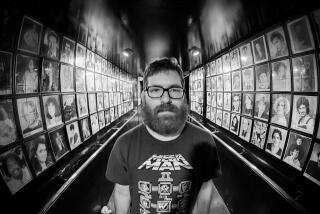LAWRENCE OF ... FRANCE?
- Share via
Before Thomas Edward Lawrence (1888-1935) became known to the world as “Lawrence of Arabia,” he was just a student named Ned at Oxford University. But it was there that the young Lawrence began to cultivate a rebel image and push himself, mentally and physically. Long-distance cycling was his workout of choice. Ten years later, the strength and stamina he gained while biking were dearly needed when, as a British officer, he helped lead the Arabs against the Turkish Empire in World War I. Even though his primary vehicle in the 1916-1918 campaign was a camel, you could say that, in some ways, the battle of Aqaba was won on the country roads of Oxford.
Lawrence chronicled the desert revolt brilliantly in his epic book, “Seven Pillars of Wisdom.” Literature, however, was not young Ned’s field at Oxford. He was fascinated by medieval military architecture, and one of Oxford’s courses of study was “Military History and Strategy.” So in the summer of 1908, at age 19, Lawrence went on a 2,000-mile bike tour of France to examine its castles and ancient fortifications. By Aug. 2, he had pedaled from Le Havre, on the English Channel, to Aigues-Mortes, near the Mediterranean, where he wrote about his adventures in this edited letter home to his mother, Sarah.
True to his Oxford education (and a habit of showing off his erudition), Lawrence sprinkled letters home with classical references. In this one he shouts, “Thalassa! Thalassa! (The sea! The sea!),” mimicking Greek soldiers who, fighting their way through Mesopotamia in 401 BC, supposedly cried out upon spying the Black Sea.
*
Sunday, August 2, 1908
Aigues-Mortes
*
Dear Mother,
I had better begin from my last letter before Vezelay. This I found superb but rather in sculpture than in proportions. . . . From Vezelay I rode to Nevers, arriving on Friday. It is a quaint rather than beautiful town, with a good Renaissance ducal palace and a fine cathedral. I telephoned from here to Dunlop in Paris for a new tyre, which after anxious waiting arrived all right on Monday. Since then all has gone like a marriage bell in the way of punctures, and I am generally happy.
The cost was however immense: with telephoning, carriage, fitting etc., it cost nearly 20 shillings; result is I’m afraid I’ll be short later on. In fact I am rather disgusted with my costs to date. The hotels all charge 2 francs for bed, and at least 2 for dinner (I don’t like going to any but fairly decent places, alone, with money). My litre of milk staggers them for breakfast (I always order it the night before, and it is amusing to watch their efforts to convince me I’m mistaken, “Monsieur does not mean a litre: it is too much”), but not sufficiently to persuade them to charge less than 75 centimes to 1 franc. Result: 5 francs are gone by the morning. Add some fruit or milk in the day, post cards (now total over 100) and postage, repair-bands, solution, tips for showplaces, an occasional bath etc. and you have a fair 7 francs per day: I had really hoped to do it cheaper. 6 shillings a day is absurd for one. . . .
From Nevers I went by Moulins to Le Puy. Tell Father I had a 20 mile hill up into Le Puy. Part of my ride was up a superb gorge, with river foaming in the bottom, and rock and hill on each side. It was the finest scenery I have ever come across. Truly the Auvergne is a wondrous district: but not one for a cycle. I’ll take a walking tour there some day, I hope.
From Le Puy I rode up for 10 miles more (oh dear, ‘twas hot!), consoling myself with the idea that my sufferings were beyond the conception of antiquity, since they were a combination (in a similar climate) of those of Sisyphus who pushed a great weight uphill, of Tantalus who couldn’t get anything to drink, or any fruit, and of Theseus who was doomed ever to remain sitting. I got to the top at last, had 15 miles of up and down to St. Somebody-I-don’t-want-to-meet-again, and then a rush down 4,000 feet to the Rhone. ‘Twas down a valley, the road carved out of the side of the precipice, and most gloriously exciting. In fact so much so that with that and the heat I felt quite sick when I got to the bottom.
I slept that night at Crussol, a fine 12th-century castle on a 500-foot precipice over the Rhone. Next day via Valence to Avignon, glorious with its town walls and papal palace, (popes lived there 90 years, and built an enormous pile) and passed thence through Tarascon to Beaucaire, into Arles.
From Arles I rode to Les Baux, a queer little ruined and dying town upon a lonely “olive sandalled” mountain. Here I had a most delightful surprise. I was looking from the edge of a precipice down the valley far over the plain, watching the green changing into brown, and the brown into a grey line far away on the horizon, when suddenly the sun leaped from behind a cloud, and a sort of silver shiver passed over the grey. Then I understood, and instinctively burst out with a cry of “Thalassa, Thalassa” that echoed down the valley, and startled an eagle from the opposite hill. It also startled two French tourists, who came rushing up, hoping to find another of the disgusting murders their papers make such a fuss about, I suppose. They were disappointed when they heard it was “only the Mediterranean!”
More to Read
Sign up for The Wild
We’ll help you find the best places to hike, bike and run, as well as the perfect silent spots for meditation and yoga.
You may occasionally receive promotional content from the Los Angeles Times.






